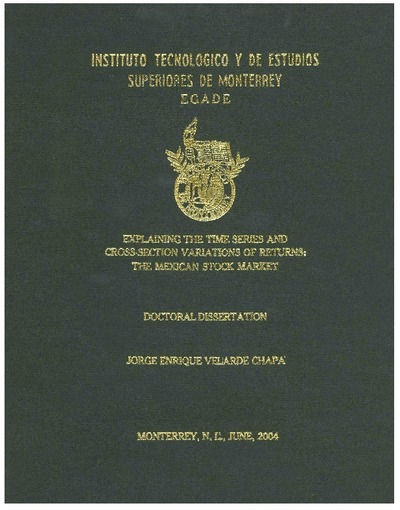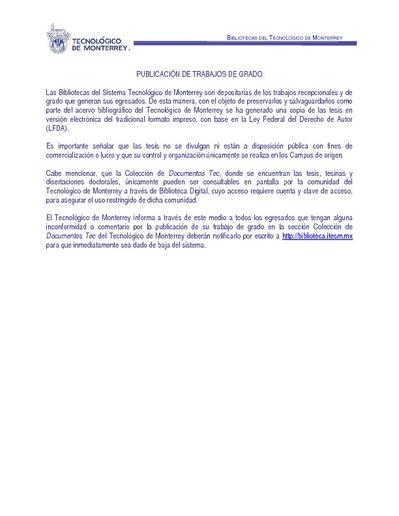| dc.contributor.advisor | Dr.Sheridan Titman | en |
| dc.creator | Velarde Chapa, Jorge E. | en |
| dc.date.accessioned | 2015-08-17T11:36:38Z | en |
| dc.date.available | 2015-08-17T11:36:38Z | en |
| dc.date.issued | 2004-06-01 | |
| dc.identifier.uri | http://hdl.handle.net/11285/572616 | en |
| dc.description.abstract | The main objective of this dissertation is to propose an Asset Pricing Model that identifies the risk factors explaining the time series and cross-section variations in the returns of the Mexican Stock Market. This analysis sheds a deeper understanding about the behavior of the returns in the Mexican Stock Market, provides foreign and local investors with new elements in order to better identify attractive investments and will enable portfolio managers to enhance their analysis when determining the optimal degree of risk exposure. The CAPM, Multi-Factor Pricing Model and the Characteristic Model were tested; grouping the stock returns according to the market betas, size and book-to-market value. The sample covered a time period from 1987 to 2001, divided in sub-periods, to evaluate the economic and financial shocks, the opening of Mexico's economy through trade agreements, and vi the Mexican financial deregulation. The results suggest that the CAPM and MultiFactor Pricing Model that include the risk factors identified by Chen, Roll and Ross (1986) and Fama and French (1993), do not explain the time series and cross-section variations of the Mexican Stock returns. When testing different risk factors and the portfolios are constructed by market betas then the excess market return, the default risk and the U.S. real interest rate can better explain cross-section variations of the average returns between 1987 and 2001. But, when the portfolios are formed according to the market size and book-to-market value, the evidence found sustains that variations in returns are captured by different risk factors according to different business conditions. From 1987 until 1994, the excess market return, size mimicking portfolio, book-to-market mimicking portfolio and exchange rate give a better explanation for the variation of the average returns. Furthermore, from 1995 until 2001, the excess market return, size mimicking portfolio, book-to-market mimicking portfolio and the default risk offer a better explanation. The evidence presented to test the Characteristic Model was not sufficient in order to discriminate between a Factor or Characteristic Model. Nonetheless, since this may be the first study which tests the model in the Mexican Stock Market, I proposed some future lines of research in this area. | |
| dc.language | eng | |
| dc.publisher | Instituto Tecnológico y de Estudios Superiores de Monterrey | |
| dc.rights | info:eu-repo/semantics/openAccess | |
| dc.rights.uri | http://creativecommons.org/licenses/by-nc-nd/4.0 | * |
| dc.title | Explaining the Time Series and Cross-Section Variations of Returns: The Mexican Stock Market-Edición Única | en |
| dc.type | Tesis de doctorado | |
| thesis.degree.level | Doctor in Philosophy in Management | en |
| dc.contributor.committeemember | Roberto Santillán Salgado | es |
| dc.contributor.committeemember | Alejandro Fonseca Ramírez | es |
| thesis.degree.discipline | EGADE Business School | en |
| thesis.degree.name | Doctoral Program in Management | en |
| dc.subject.keyword | Mexican Stock Market | en |
| dc.subject.keyword | Time Series | en |
| dc.subject.keyword | Cross Sections | en |
| dc.subject.keyword | Returns | en |
| thesis.degree.program | Campus Monterrey | en |
| dc.subject.discipline | Negocios y Economía / Business & Economics | en |
| refterms.dateFOA | 2018-03-25T05:57:06Z | |
| refterms.dateFOA | 2018-03-25T05:57:06Z | |
| html.description.abstract | The main objective of this dissertation is to propose an Asset Pricing Model
that identifies the risk factors explaining the time series and cross-section variations
in the returns of the Mexican Stock Market. This analysis sheds a deeper
understanding about the behavior of the returns in the Mexican Stock Market,
provides foreign and local investors with new elements in order to better identify
attractive investments and will enable portfolio managers to enhance their analysis
when determining the optimal degree of risk exposure. The CAPM, Multi-Factor
Pricing Model and the Characteristic Model were tested; grouping the stock returns
according to the market betas, size and book-to-market value. The sample covered a
time period from 1987 to 2001, divided in sub-periods, to evaluate the economic and
financial shocks, the opening of Mexico's economy through trade agreements, and
vi
the Mexican financial deregulation. The results suggest that the CAPM and MultiFactor
Pricing Model that include the risk factors identified by Chen, Roll and Ross
(1986) and Fama and French (1993), do not explain the time series and cross-section
variations of the Mexican Stock returns. When testing different risk factors and the
portfolios are constructed by market betas then the excess market return, the default
risk and the U.S. real interest rate can better explain cross-section variations of the
average returns between 1987 and 2001. But, when the portfolios are formed
according to the market size and book-to-market value, the evidence found sustains
that variations in returns are captured by different risk factors according to different
business conditions. From 1987 until 1994, the excess market return, size mimicking
portfolio, book-to-market mimicking portfolio and exchange rate give a better
explanation for the variation of the average returns. Furthermore, from 1995 until
2001, the excess market return, size mimicking portfolio, book-to-market mimicking
portfolio and the default risk offer a better explanation. The evidence presented to test
the Characteristic Model was not sufficient in order to discriminate between a Factor
or Characteristic Model. Nonetheless, since this may be the first study which tests the
model in the Mexican Stock Market, I proposed some future lines of research in this
area. | |


